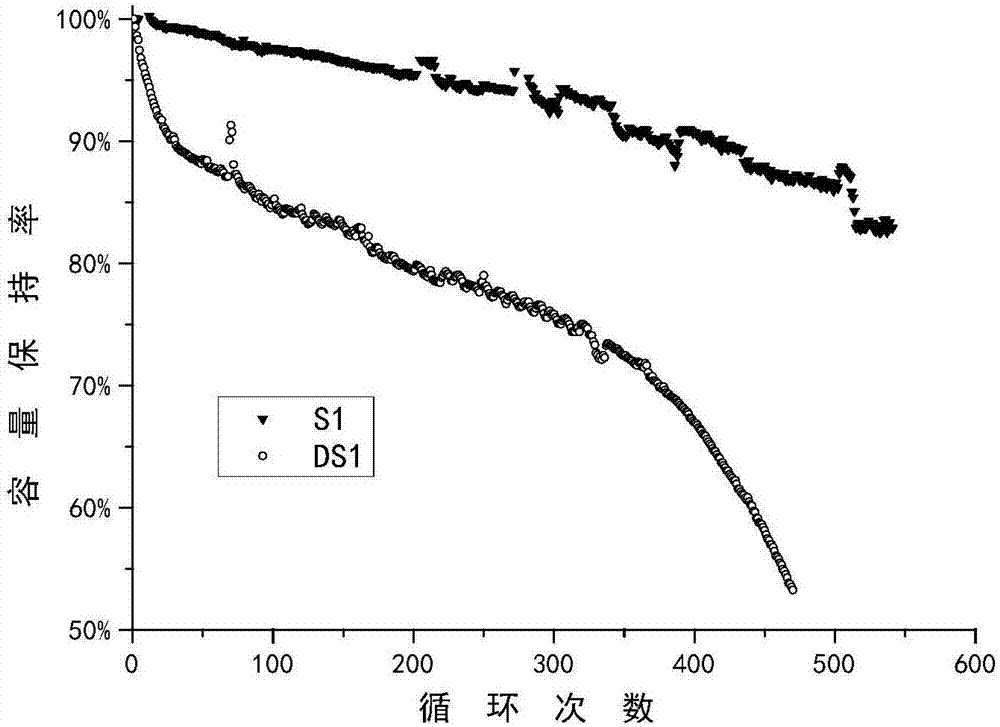Electrolyte used for 5V high-voltage lithium secondary battery and lithium secondary battery containing same
A lithium secondary battery, electrolyte technology, applied in the direction of secondary battery, secondary battery repair/maintenance, circuit, etc., can solve the problems of high temperature and poor cycle performance, achieve excellent performance, improve high temperature storage performance and cycle performance , the effect of improving cycle performance
- Summary
- Abstract
- Description
- Claims
- Application Information
AI Technical Summary
Problems solved by technology
Method used
Image
Examples
Embodiment 1
[0030] Battery production:
[0031] Positive electrode preparation: the positive electrode material ratio is: lithium nickel manganese oxide, acetylene black (conductive agent), polyvinylidene fluoride (PVDF, binder) mass ratio is 95:2.5:2.5. Add PVDF to N-methyl-pyrrolidone, stir evenly at high speed, add acetylene black to the solution, stir evenly, then add lithium nickel manganese oxide and stir evenly to form positive electrode slurry, coat positive electrode slurry on aluminum foil, and The positive electrode sheet is baked, compacted, cut, and welded.
[0032] Negative electrode preparation: The ratio of negative electrode materials is silicon-carbon composite material, acetylene black, carboxymethyl cellulose (CMC), and propylene butyl rubber (SBR), with a mass ratio of 95:1.0:1.5:2.5. Add CMC to water, stir at high speed to dissolve completely, then add acetylene black, continue to stir until uniform, continue to add silicon-carbon composite material (Si content is 3...
Embodiment 2
[0036] Adopt the preparation method of embodiment 1 electrolyte to prepare electrolyte A2, the difference is that the additives added are fluoroethylene carbonate, phthalic anhydride, triphenyl phosphite, glyceryl tristearate, and the additions are followed by Accounting for 15.00%, 2.00%, 0.10%, 0.50% of the total mass of the electrolyte, and finally adding lithium hexafluorophosphate accounting for 17.00% of the total mass of the electrolyte to the mixed solution. The remaining components are non-aqueous organic solvents, and the non-aqueous organic solvents are TMS, EC, DMC, and EMC mixed solutions (mass ratio is 1:2:5:3), accounting for 65.40% of the total mass of the electrolyte.
[0037] The lithium secondary battery S2 was prepared according to the method of Example 1 by using the above electrolyte solution. The difference is that the positive electrode material is lithium nickel manganese oxide, and the negative electrode material is graphite material; the rest are the...
Embodiment 3
[0039] The preparation method of the electrolyte in Example 1 is used to prepare the electrolyte A3, except that the additives added are vinylene carbonate, ethylene carbonate, 3-methyl-benzene-1,2,4,5-tetracarboxylic Acid-1,2,4,5-dianhydride, dicyclohexylcarbodiimide, glycerol trioleate, the added amount accounted for 0.50%, 0.50%, 3.00%, 0.10%, 0.50% of the total mass of the electrolyte in sequence , and finally add lithium hexafluorophosphate accounting for 14.40% of the total mass of the electrolyte to the mixed solution. The remaining components are non-aqueous organic solvents, and the non-aqueous organic solvents are TMS, EC, DMC, and EMC mixed solutions (mass ratio is 1:2:5:3), accounting for 81.0% of the total mass of the electrolyte.
[0040] The lithium secondary battery S3 was prepared according to the method of Example 1 by using the above electrolyte solution. The difference is that the positive electrode material is lithium nickel manganese oxide, and the negat...
PUM
 Login to View More
Login to View More Abstract
Description
Claims
Application Information
 Login to View More
Login to View More - R&D
- Intellectual Property
- Life Sciences
- Materials
- Tech Scout
- Unparalleled Data Quality
- Higher Quality Content
- 60% Fewer Hallucinations
Browse by: Latest US Patents, China's latest patents, Technical Efficacy Thesaurus, Application Domain, Technology Topic, Popular Technical Reports.
© 2025 PatSnap. All rights reserved.Legal|Privacy policy|Modern Slavery Act Transparency Statement|Sitemap|About US| Contact US: help@patsnap.com



